Kyoto is one of Japan’s former capitals and is often regarded as the home of the country’s traditional culture – those Higashiyama things we talked about already. I figured this made it the perfect place to experience that culture first hand, albeit in a touristy kind of way. My first stop was a place called Wak Japan, whose brochure I picked up in my hotel in Kyoto. Geared to foreign tourists, I figured it might not be super authentic, but would give a reasonable glimpse at some of the more refined Japanese arts. I chose to do two programs in one afternoon: tea ceremony and origami.
The tea ceremony was held in a lovely tatami room that looked onto a tiny, perfect garden. I was expecting to share the experience with a bunch of other Western tourists but it turned out that everyone else in the group was Japanese – six women from other parts of the country who were in Kyoto as tourists themselves. It seems the Japanese are great fans of traveling within their own country, which I think is great and perfectly understandable. Apparently this was an unprecedented occurrence, such a pronounced Western/Japanese imbalance, and the woman running the program was worried about me. Ha! Little did she know that she was dealing with an experienced world traveler who would no more be thrown off by a room full of Japanese tourists than she would by a delayed flight, a lost wallet or plate of worms.
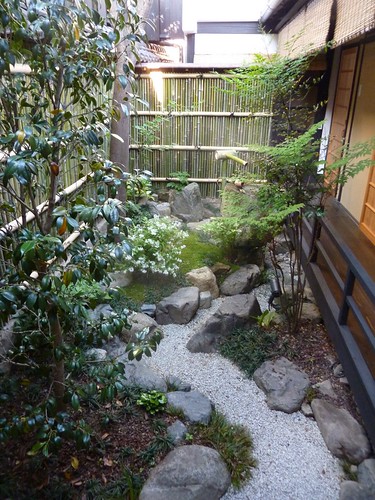 The tiny perfect garden
The tiny perfect garden
It turned out to be very nice being with all those Japanese women. They were super polite and friendly and very concerned about making sure I understood everything and had a good time. The only difficult part was spending so much time sitting on the floor. This is something I’ve found to be common to most Asian cultures, this ground-level existence, and even though Japan gussies things up with tatami mats, it’s still damned uncomfortable spending that much time kneeling. I was largely crippled when the hour was finally over.
Luckily most of the commentary was conducted in English, since it’s normally done for foreigners. I learned about how the green tea is grown, picked, dried, and ground into matcha, the special powdered tea used in the tea ceremony. And then we got to watch one of the women at Wak perform the tea ceremony.
She entered in a beautiful kimono, knelt down in front of the water boiler and began. All of the movements in the tea ceremony are prescribed – how the cloth is held and folded while wiping the tea scoop, how the tea bowl is washed and dried, how the water scoop is grasped and released. It was in some ways rigid and yet also very graceful. And once the water was poured over the powdered tea and whisked into a green froth, it was presented. Presented to me of course, because all the other women insisted that I should have the first cup. I was instructed in the proper way to receive the cup, bowing with hands flat on the floor. Then I placed the bowl between me and the person next to me and said in very coached Japanese, “Excuse me for going before you.” And to the woman who made the tea, “Thank you for making this tea for me.” There was a specific way to hold the bowl and a specific way to drink it, in three or four gulps, one right after another. And there was a specific sort of inhaling slurp noise to be made at the end to indicate that the tea was so excellent you just had to suck back every drop. Then the bowl was to be placed back on the floor in front of you. After that, it’s customary to pick up the bowl again and inspect the decorations more carefully, handing it around so others can see it too. Appreciating the artistry of the bowls and other utensils is all part of the experience.
Each woman in the group was served a cup of tea made by our hostess, then it was our turn to try making tea ourselves, and who was first up to bat? You guessed it! I acquitted myself pretty well, though I had to start over once because I added too much water to the tea the first time. (I plead inadequate instruction.) Despite that initial misstep everyone was very impressed with my whisking. Apparently foreigners almost never get the tea whisked into a proper froth, so there were many murmurs of appreciation at my savant-like whisking skills.
I was very pleased to have the chance to experience a tea ceremony from both sides, and it was nice to do it with real Japanese people instead of a load of whisk-challenged foreigners. The two women conducting the experience were lovely and friendly. One of them, Asa, was also the one who sat with me for another hour (on stools, thank God) teaching me some origami. I was the only one who’d signed up for origami that day so it was just the two of us, which made for a very genial time. I took the opportunity to quiz her on how to say a few Japanese phrases, and we folded and chatted and had a great time. And apparently it’s not just my whisking skills that are above average because Asa was very impressed with my origami too, and with my grasp of the concept of wabi, as evidenced by my wallet. (See, I told you people comment on it!)
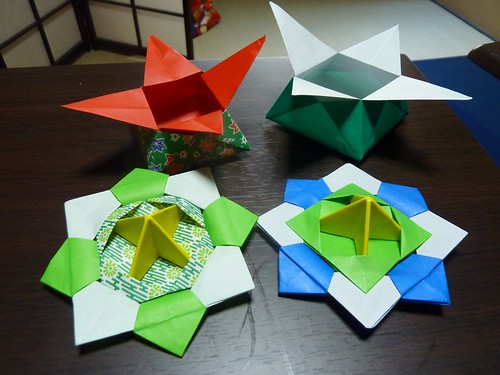 A few of our origami projects – flower petal boxes and spinning tops
A few of our origami projects – flower petal boxes and spinning tops
On my last evening in Kyoto I joined a walking tour of Gion, the most famous geisha district in Japan, and the setting for much of the popular novel “Memoirs of a Geisha”. The tour was called “Night-time Exploration in Gion” and promised to explain the history and life of the traditional geisha in Kyoto, while walking the backstreets of Gion. It was only ¥1,000 ($10.00 - what a brilliantly easy exchange rate! Just one more thing to love about Japan.) and turned out to be worth much much more than that. Emi, our guide, was fantastic and gave us exactly what the tour promised, so I can tell you some really interesting facts about geisha.
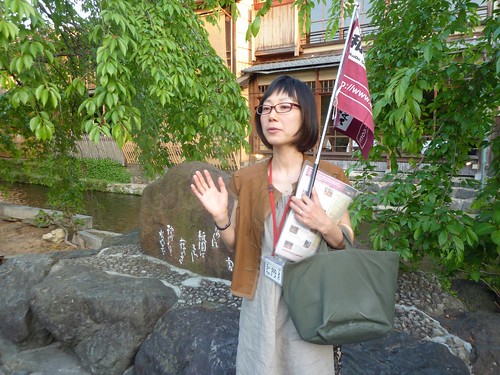 Emi, standing beside Gion’s Shirakawa River, reciting the poem inscribed on the rock behind her. It’s by Isamu Yoshii (1886-1960), and translates something like: “No matter what they say, I love Gion. Even in my sleep, the sound of water flows beneath my pillow.”
Emi, standing beside Gion’s Shirakawa River, reciting the poem inscribed on the rock behind her. It’s by Isamu Yoshii (1886-1960), and translates something like: “No matter what they say, I love Gion. Even in my sleep, the sound of water flows beneath my pillow.”
First of all, they are not called geisha in Kyoto. It’s apparently quite insulting to call the Kyoto variety geisha. The term used in Kyoto is geiko (“GAY-ko”), which differentiates between the Kyoto variety and the much less traditional Tokyo type. And it’s important to understand that geiko are NOT prostitutes. They’re entertainers highly trained in traditional Japanese arts like music and dance. A qualified geiko makes her own money by attending parties held a tea houses and entertaining the guests there with performances, games and sparkling conversation. They’re expensive, sought-after and somewhat mysterious. The cost to the patron for a 90 minute party with one geiko and one apprentice (not including food) is about $1,000.
The other world we learned was Maiko (“MY-ko”), which is the term for an apprentice geiko. Emi talked a lot about the maiko, and it was fascinating. They usually start their apprenticeships around age 15, and serve a probationary year as a sort of house-girl/maid in the boarding house they move into. Every maiko is sponsored by a boarding house mother who pays for the girl’s board, training and clothing for her entire apprenticeship, which is usually about five years long. After the girl’s probation period is over and her boarding house mother determines she’s fit to become a maiko, the real work starts. She must learn traditional arts, keep her hair up in an intricate style all the time, attend parties along with a qualified geiko, and earn enough money to eventually pay back her boarding house mother. It’s a weirdly archaic lifestyle, and fewer than 40 maiko are now known to be living in Gion. The total number of maiko and geiko combined in Kyoto is around 300, whereas at the height of their popularity several hundred years ago, there were as many as 3,000.
Maiko are not allowed to go out except in traditional dress, and that dress is elaborate. They’re not allowed to have cell phones, they’re not allowed visits from their family and they only get to go home very rarely, maybe once a year during a big festival. It’s a very restrictive, difficult lifestyle. But if a girl survives and flourishes, she can become a geiko, earn her own money, go out on the street in normal clothes and live in her own house. And popular geiko can earn a lot of money. It’s estimated that the number one geiko in Kyoto earns as much as the CEO of Toyota.
We were lucky enough to see a maiko as she was leaving her boarding house to go to a party. Naturally, they are kind of tired of tourists trying to get photographs of them, and they move quickly to get where they’re going, so let's just call this an action shot and leave it at that.
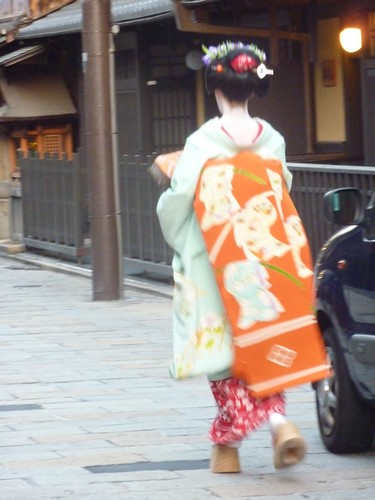 She was moving fast, despite wearing those crazy shoes!
She was moving fast, despite wearing those crazy shoes!
Emi told us a lot more about Gion, and geiko and maiko, and about the tea houses and the tea house parties within. There’s just too much rolling around in my head to tell it all here, but it was fascinating. (This Wikipedia article is really good and tells a lot of what there's no room for here.) I finished that tour happy with life and ready for supper, which means it’s time to talk about food again.
Specifically, let’s talk conveyor belt sushi! I found a place in the LP that was so great I went two nights in a row and stuffed myself. It was a long counter with seats all around and a couple of sushi chefs in the middle. And there was the conveyor belt, like a miniature version of the things they use as luggage carousels in airports. You sat down at a stool, filled up on green tea (or ordered a beer… guess what I did…), poured a bit of soy sauce into a small dish and grabbed the first tasty looking plate that went by. Every once in a while the chefs would stick another few plates into the mix and cause the whole business to back up alarmingly, but they never let it go long enough that there was a total derailment. These guys were pros.
It was great. Every plate was the same price - ¥137 – so it was cheap enough that you could be adventurous and try a few weird things. I had one with raw quail egg, and I had uni, and something pink and stringy and… well, I had a lot. You could even request something special from the chefs and they’d make if up for you on the spot for the same price. On my second visit I got up the gumption to ask for another round of shrimp with avocado, mayo and sliced raw onion and it was YUM. And even though I stuffed myself and had two beers the bill was only about $20, and the fun factor was through the roof. On my first visit I was seated next to a friendly Australian guy who I chatted with the whole evening. We ended up walking around the area for a while after we finished gorging on sushi, and had a great conversation. (Nice to meet you Adam!). That conveyor belt joint really had it all – cheap sushi, a great gimmick, beer, and engaging dinnertime conversation, all in one easy to navigate package just a few blocks from my hotel.
And that was Kyoto. It’s a city you could easily spend weeks in, especially if you’re a fan of Buddhist temples. Even I, templed-out as I was, felt sad to leave it. But time is ticking away on my big year-long adventure, and I have more of Japan to see. I can’t believe that, as I write this, I’ve only got a week left before I fly back to North America. I think I’m in for a big big shock.
Random Japan fact: Those half-curtains that hang in doorways of shops and restaurants? They mean the place is open for business! No curtain means the shop is closed.


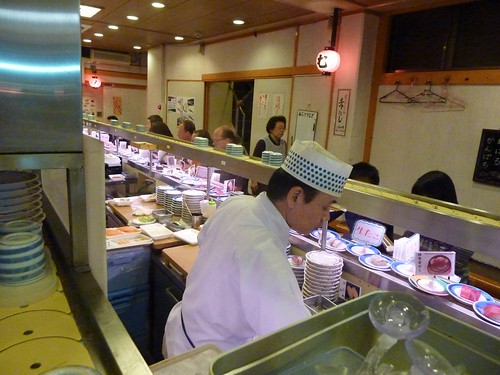


2 Comments:
I, unlike the Japanese tea ladies, am not at all surprised by your savant qualities!
of all places where they also have conveyor belt sushi? syracuse new york! I've been there and it is lots of fun! there, the plates are different prices based on the colour of the plate.
Post a Comment